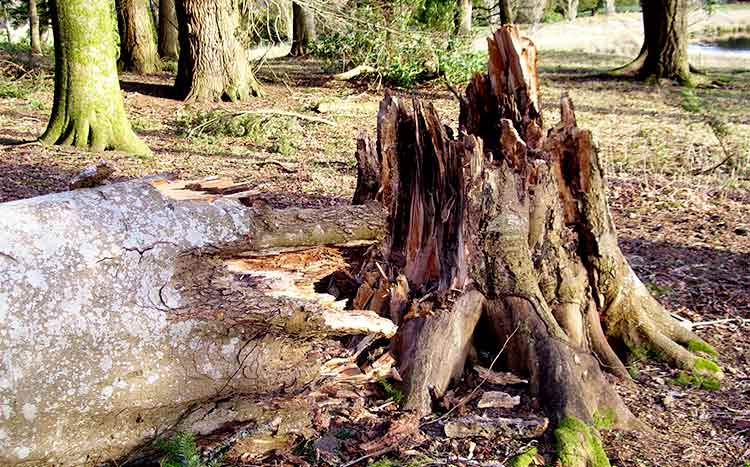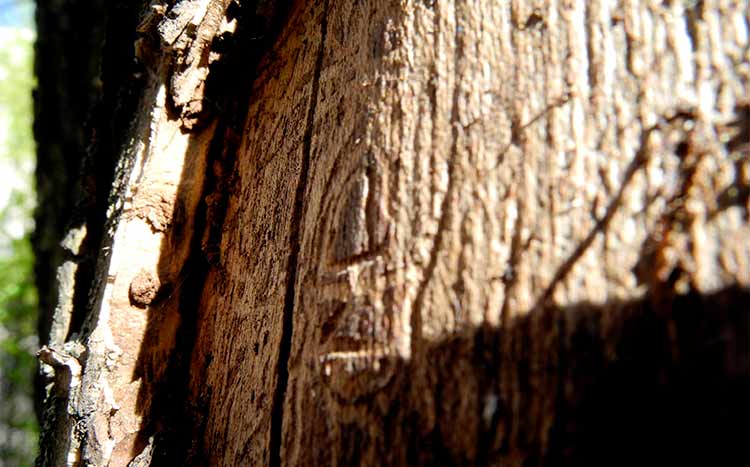A tree’s base is essential to a tree’s survival because it contains critical parts of a tree’s transportation system. All the nutrients and water that the tree needs in order to survive and thrive have to pass through it. Therefore, any rotting that happens in this area is an understandable cause of concern. This is so especially when you consider that rotting is a sign of a dying or dead tree.
In most cases, if you have a tree that is rotting at its base, the best thing that you can do is nothing — as far as treating or sealing the rotting area is concerned. This is because trees are usually adept at sealing off wounds and when they are given a chance, they can effectively seal off the rotting area, develop a new bark, and resume their healthy growth trajectory. During this period, all that the tree will need is a healthy amount of water and nutrients. Therefore, watering and fertilizing it are great ways of boosting its chances of overcoming a rot-in-base problem.
Here is what you should know about tree rotting and what you can do to save your tree.

Table of contents
ToggleWhat you can do
While rotting is a serious symptom, a tree that experiences rot at its base rarely needs you to treat the rot directly. All it needs are ideal growing conditions that will allow it to heal itself. The main reason why direct intervention is discouraged is that most of the popular rot-treating options usually cause more trouble than they help.
For example, sealing the rotting area with tree paint and wound dressings does little, to nothing, when it comes to stopping infections. In fact, the wound seals sometimes create pockets that can make rotting even worse. Therefore, instead of trying to seal or cut out the rotting part, you should consider any of the following options.
Tip 1: Let your tree handle the problem
Trees are good at sealing off wounds and protecting themselves from advanced rotting. Therefore, if the rot isn’t as widespread and if your tree is in generally good health, letting your tree handle the rotting problem is a good idea. Given enough time, it will produce chemicals and agents that will keep the rot from spreading and it will eventually develop a new bark.
Tip 2: Watering and applying fertilizer
Since rotting is a common sign of a weak, injured, or dying tree, making sure that the tree has enough water and nutrients is a great way of improving its chances of surviving a rotting base. Doing so will ensure that it has all the resources that it needs to fight off wood decay. It will also make it easier for the tree to develop new tissues.
Therefore, applying the right fertilizer and ensuring that the tree has an ample supply of water is a great way of boosting the tree’s chances of overcoming a wood decay attack.
Tip 3: Pruning
A tree that has a rotting base is already under a lot of stress. Therefore, anything that you can do to relieve its stress will go a long way towards improving its odds of recovering.
Pruning, when done right, is a great way of relieving the burden that a tree has to shoulder. This is true both in terms of resources and weight. For example, if you cut off dead or dying branches, the tree’s trunk will have less weight to bear and this may save the tree from falling off — especially given the weakened base.
Tip 4: Remove the tree
If the rotting has advanced to the point where it is compromising the structural integrity of the tree, then removing the tree is an option that you should definitely explore. This is because a tree with a weakened base is a hazard. It can fall on loved ones and injure them. It can also fall on property and utilities, and hence causing damage and unnecessary conflicts.
Should I fix tree rot myself or call a Pro?
You should call a pro as soon as you notice that your tree’s base is rotting. This is because an arborist has the experience, expertise, and training to properly assess whether the tree can be saved or not. Their wealth of experience also gives them an edge in terms of determining the right approach to saving the tree. As a result, they will save you from having to rely on trial-and-error as a means of saving a tree that is likely dying.
What causes rot in base of tree?
Injury from natural events
Storms, forest fires, animals and birds routinely damage trees. They inflict wounds that damage a tree’s bark and as a result leave the tree vulnerable to decay-causing fungi.
Injuries from construction equipment, automobiles and lawnmowers
Human beings also contribute to incidences of tree rotting at their bases. This typically happens due to construction, driving and landscaping activities. Accidents that occur due to these activities routinely injure trees and as a result leave the door open for decay-causing agents.
Pests and diseases
Diseases and pest infestations weaken trees. They can also create open wounds that act as an invite to harmful fungi. Both of these things lower the tree’s ability to heal and stop the rotting process. They eventually encourage rotting at the base of the tree.
Old age
Some tree species rot in their advanced ages as part of their natural cycle. For such trees, there is really nothing that one can do to stop the rotting.
Signs of early rot in base of tree
The following are the most common signs that your tree has a rotting problem at its base.
Sign 1: Mushrooms at the base of the tree
If you notice mushrooms growing on your tree, especially if they grow in a shelf-like formation, chances are that the tree is dying or that part of the tree has started rotting.
Sign 2: Carpenter ants
Carpenter ants rarely infest a healthy tree. Therefore, if you see them on your tree’s base, chances are that part of the tree is dying or rotting.
Sign 3: Conks and knots on the tree’s bark
These are usually created by fungi that prey on dead or dying trees. Therefore, even if your tree still has foliage and it starts developing conks and knots, chances are that part of its base is dying.
Can I Prevent a tree from rotting?
Yes, you can prevent a tree from rotting by protecting it from physical trauma. This means shielding it from accidental damage from construction activities, or any other activity that may end up injuring the tree’s bark, by installing a fence around the tree.
You can also spray the tree with pesticides that are designed to keep pest infestations at bay. And since most pests create wounds that eventually lead to rotting, doing so will help to reduce the chances of the tree rotting.
However, it is important to keep in mind that rotting in older trees is sometimes inevitable. And for these trees, there is really nothing that one can do except help to stop the spread of the rotting.

Use this free service to find a tree expert near you
If you have a tree that is rotting at its base, contacting an arborist as soon as possible is advisable. And the best way to do so is to start by visiting GoTreeQuotes.com. It offers a free service that quickly matches you with the top-voted local tree care experts in your area.
Using the website, you can get 3 estimates fast by real certified experts in your area in just 2 minutes. Here is how it works.
- You scroll to the top of the page and enter your Zip code.
- Answer questions about your ant infestation problem
- Your details will be forwarded to three local experts.
- You will then receive a price estimate for the job and some friendly advice.
IMPORTANT: There is no obligation to hire. This is a free tool and service to be used at your pleasure.
FAQ's
The most effective way of knowing whether a tree is dead is to carry out a scratch test. The test involves using a knife or even your nails, to scratch the bark of the tree. The tree will still be alive if after scratching past the tough outer bark layer, you see a green layer. However, if all you see is a brown layer, then chances are that the tree is dead.
Other obvious signs of a tree that isn’t dead include the presence of new foliage and twigs that don’t snap when bent.
A tree should be removed when its structural integrity is compromised. This is because when a tree is weak and can no longer support its own weight, it can easily fall. This will expose your loved ones and members of the public to the risks of injury.
A tree should also be removed if it has a pest infestation or disease that it cannot recover from. Removing it will be necessary as a way of keeping the disease or pests from spreading to nearby trees or constructions.
It usually takes between 4 years to 5 years for a tree base to rot — that is after injury or exposure to rotting agents. However, the period usually varies widely depending on the type of tree, the condition under which it is growing, the extent of the wound, and the type of pests or disease that triggered the rotting.






